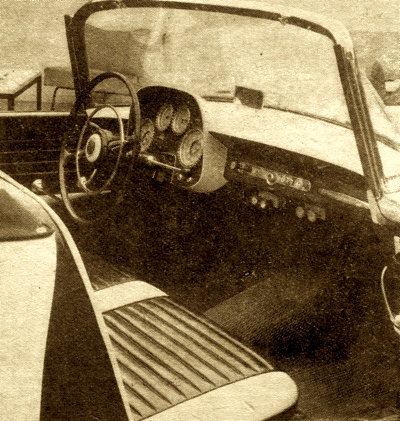Seat Cordoba Cupra Sport
Reviewed by Unique Cars and Parts
Our Rating: 4
Introduction
The SEAT 1400 was a rear-wheel-drive four-door sedan mid-size car launched by the Spanish car maker SEAT between 1953 and 1963, the first model ever produced by SEAT and the first car to be assembled at the firm's new plant located in Barcelona's Zona Franca zone. The car was a rebranded Fiat 1400, itself Fiat�s first integrated chassis model.
Production started on November 13, 1953, carried out by an early workforce of 925 employees with a potential of 5 units produced per day, and the first SEAT 1400 car rolled off the assembly line with the licence plate 'B-87.223'. Initially in 1953 components were shipped as CKD kits from Italy and assembled by SEAT at their plant in Zona Franca, but in a quite short term from 1954 the Spanish-made parts rose to a 93% proportion of the total in order to limit imports from one part and from another part to help the development of the almost non-existent Spanish supplier industry, thus fulfilling SEAT's assigned key role in the development of the Spanish economy as the national car maker of the post World War II Spain.
In the next few years the model's production output would gradually increase, and by 1956 10,000 cars would be produced annually, with an average of 42 cars per day. In 1963, when the car was replaced by the SEAT 1500, 82,894 examples covering four distinctively different versions of the 1400 had been produced. The first SEAT 1400, offered between 1953 and 1955, incorporated a 1395 cc four-cylinder water-cooled Fiat engine with a claimed output of 44 bhp and top speed of 116 km/h (72 mph).
SEAT 1400 A
The SEAT 1400 A, the first revision, launched for 1955 was a modernised version of the original 1400, based on the Fiat 1400 A which had appeared from Turin the previous year. Published power output was now raised to 50 bhp and the top speed to 125 km/h (78 mph).
SEAT 1400 B
Announced at the end of 1956, the SEAT 1400 B appearing for 1957 retained its predecessor�s bodywork but featured a revised front grill and offered a two tone paint scheme. In addition to the sedan, a five-door station wagon and commercial delivery truck version were available. Claimed engine output and maximum speed for the sedan were now 58 bhp and 135 km/h (84 mph). This version of the 1400 would continue in production until 1964.

SEAT 1400 Sport Interior.
|
SEAT 1400 C
The SEAT 1400 C was introduced in 1960. The modern Pininfarina styled body, came from the recently introduced Fiat 1800. The previous SEAT 1400 B remained in production: the two cars were offered in parallel, sharing the same engine, though the newer car was longer and, it appears, slightly heavier than the old. The decision to fit the old four-cylinder unit in the new bodied SEAT rather than to tool up for assembly in Catalonia of the new six-cylinder engines being fitted by Fiat in the new-bodied cars appears to have been taken on cost grounds: disposable incomes in Spain at this time were far lower than those in Italy. In 1963 a five-door estate version of the 1400 C appeared, featuring a two piece tailgate. The introduction of a diesel-engined version would have to await the successor model, however.
SEAT 1400 Sport
Since the end of World War 2 the lovely Latin line of the world's most elegant automobiles had been largely the product of fertile Italian minds. By
1959 however, another Latin race, the Spanish, were making a determined bid in the car design field, led by a gifted body stylist named Serra. The vehicle that established this man's reputation as a designer of note is the Seat 1400 Sport. The Spanish Seat was powered by an Italian
Fiat engine, made in Barcelona under licence from the Italian firm. As a small sideline to full scale assembly line production of popular work-a-day cars, the Seat factory was crafting a very few of the 1400 Sports. In
1959 they were still virtually in the experimental stage, troubled by some bugs the designer had yet to eliminate. But they showed great promise nevertheless.
The 1400 Sport was an example of integral construction: there was no chassis, and the wheels and suspension were "hung" from the body. And this gave rise to the model's major bug. The thicker the body from top to bottom, naturally the stronger the car was overall. But because of the big doors the middle of the body was necessarily very thin, and so disconcertingly weak there. The SEAT 1400 Sport had independent four wheel
suspension, by swinging arms at the front with
coiled springs, hydraulic telescopic double-acting shock absorbers and a stabiliser bar. The back
suspension consisted of
leaf springs with hydraulic telescopic double-acting shockers, and stabiliser bar. Braking was hydraulic on all four wheels, and a handbrake worked on the transmission.
The 1400 Sport was powered by a modified four cylinder Fiat 1400 engine with valves in head, wet cylinder sleeves, a mechanical fuel pump, and twin injection-type carburettors. It had a dry single plate clutch, and four forward gears and reverse, manipulated by a shift lever on the steering column. Gear ratios are: 3.86 to 1 in first; 2.38 to 1 in second; 1.57 to 1 in third; 1 to 1 in top.



